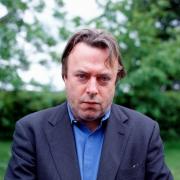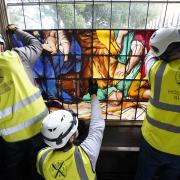Who was the famous New Forest legend and what did he want with all those snakes?
When I announced on social media I’d been to Brockenhurst in search of Harry ‘Brusher’ Mills (1840-1905), the so-called ‘Snakecatcher’ of the New Forest, I was immediately informed that he was (or is): ‘A legend around these parts.’
Harry was indeed a living legend in Victorian times, a catcher of snakes who inhabited a cone-shaped hut comprising branches and turf, the kind of structure we associate more with Celtic or Anglo-Saxon times. A lot of the photographs and other representations we have show him in typical guise, posing with his adversaries (snakes), and with his tools of the trade: A forked stick to drive them out of hidey-holes; a pair of tongs dangling from his waistcoat for picking up the live creatures, or specimens as they became when they were bundled off to zoological research centres; and tins for the collection thereof.

Born at Emery Down, near Lyndhurst, on March 19 1840, Henry (‘Harry’) Mills lived in this part of the Forest until 1861 at least, by which time he was a young man of around 21. He was the son of a forester and in his earlier life worked as a gardener, the details of which are scanty, although we know he also did some labouring, and in fact we don’t do any better with the next 20-odd years. We do know however, that he came to live about a mile north of Brockenhurst in an old charcoal burner’s hut in around 1880. He took up snake catching as a way of earning a living, removing the unwanted visitors from local properties whilst armed with a forked stick, sack, and little else. Some tales may be apocryphal but it’s said he created and flogged ointments, created from the snakes he cornered, whilst others were boiled with their skeletons sold to intrigued tourists. He certainly wouldn’t be able to get away with this stuff today as all New Forest reptiles are protected.
Incidentally, that nickname of ‘Brusher’ came about because he was a regular ‘brusher’ of the wicket on the local cricket field at Balmer Lawn where the hotel now stands. Ever the entrepreneur, Brusher didn’t do this out of the goodness of his heart but was paid to sweep the wicket between innings. He had universal respect, a man renowned for honesty and tidiness, which might not be the first thought coming into one’s head given his appearance and humble abode. He wasn’t that easy to engage in conversation though. Born with a cleft palate, he may have preferred to shun society and live the hermit’s life. And the snakes? Well, they held no great fear for him. If he was bitten, and that did happen, then he simply set to, cutting out the affected area with his pocket knife and plonking on his own ointment. My wife, a noted ophidiophobe (she has a snake phobia) is much impressed by all this. If we do get snakes in our house, a rare occurrence I admit, it is up to yours truly to remove them. If we get spiders (I’m an arachnophobe) then it’s my wife’s turn. It's fair to say she’s far busier.

Harry certainly did well out of his rustic business, selling the snakes he caught not just in and around Brockenhurst but throughout the Forest. It’s been estimated he caught some 6,000, of which several found their way to London Zoo, not as exhibits but as food for other snakes and birds of prey. Other sources credit him with far more ‘catches’, maybe five or six times as many. If you were a snake you probably didn’t want to get caught by Harry as repatriation doesn’t seem to have been an option. Mills’ fame spread after he’d featured in the national press. I guess, with Britain becoming the ‘Workshop of the World’ under the Victorians, this kind of rural craft must have appeared enchanting. Visitors headed for the New Forest hoping to catch sight of him and if they were lucky get a ‘selfie’ with him, buy his lotion, be entertained by his country wisdom and head back to the smoke having had a thoroughly enjoyable day out. He was a regular at local fairs where he’d also be in demand.

It’s said his hut was wrecked possibly by some disgruntled locals who were against him claiming squatter’s rights. Apparently, he then set up home in one of the outbuildings at Brockenhurst’s Railway Inn, which was his favourite ‘local’. That would have been the most substantial abode he’d had since arriving on the outskirts of the village, except for a spell in the workhouse after he’d caught influenza. Sadly, however, the destruction of his home appears to have hastened his end. The story goes that he popped into the Railway Inn for bread & pickles, and a pint, and was later found dead in one of the outbuildings, presumably the one he’d adopted. At the inquest his age was recorded as 65 and the cause of death attributed to heart failure. It’s fair to say the death of Brusher, a genuine local character, was mourned by all who’d met him or knew his story. He may have passed on but his legend didn’t and he remains a part of New Forest folklore to this day.
Harry Mills lies buried in the lower cemetery of St Nicholas’ Church in Brockenhurst. It’s tucked away up a lane, the kind of remote spot where an adder might bask in the sun. His headstone is impressive, as befitting a local legend, the marble headstone funded by the locals to whom he’d endeared himself. There’s a depiction of him doing his work, adorned in his archetypal wide-brimmed titfer, and below that the words: ‘This stone marks the grave of Harry Mills (better known as ‘Brusher Mills’), who for a long number of years followed the occupation of snake catcher, in the New Forest, his pursuit and the primitive way in which he lived, caused him to be an object of interest to many. He died suddenly July 1st 1905, aged 65 years’.

I visited the Snakecatcher pub in Brockenhurst which is named in Brusher’s honour and incorporates some of the village’s oldest buildings, which were used for stabling for the coaching business prior to the coming of the railway in 1847. It’s just a pebble’s lob from the level crossing and station, which tells us this was formerly the Railway Inn, the hostelry Brusher came to, which was established when the railway arrived. The pub was renamed The Snakecatcher in 1983.



























